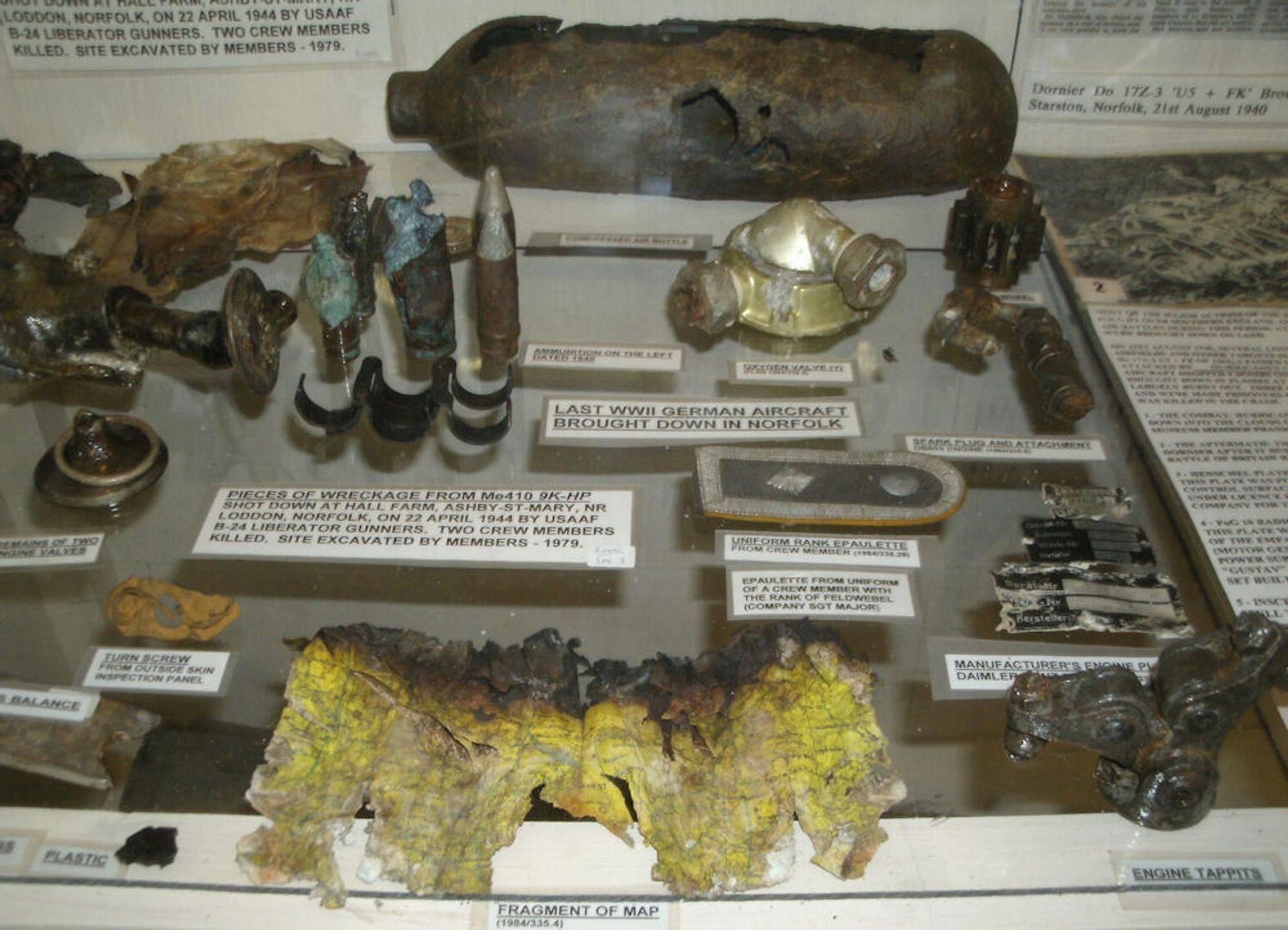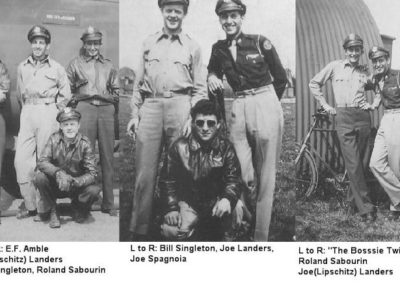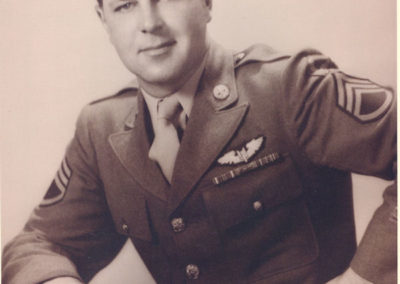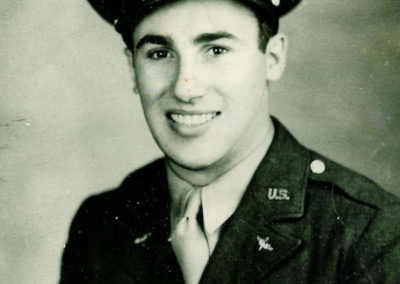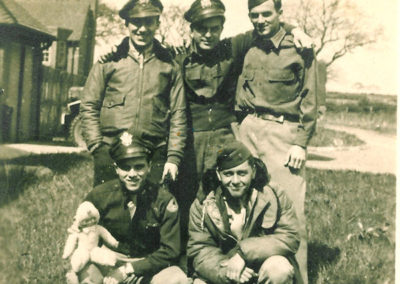Crew 70 – Assigned 755th Squadron – October 21, 1943

(Photo: Larry Forrest)
Completed Tour
| Rank | Name | Serial # | Pos | Date | Status | Comments |
|---|---|---|---|---|---|---|
| 1Lt | Harold W Wells | 0738518 | Pilot | Jul-44 | CT | Trsf to 12RD AAF 591 |
| 2Lt | Keith C Dills | 0886823 | Co-pilot | Jul-44 | CT | Trsf to 12RD AAF 591 |
| 2Lt | Louis Glauser | 0752918 | Bombardier | 03-Mar-44 | UNK | Mission Load List |
| F/O | Joseph Lipschitz | T61309 | Navigator | 16-Apr-44 | TRSF | Transferred to 392nd BG |
| T/Sgt | Leonard L Perkins | 38235527 | Radio Operator | May-44 | CT | Awards - Distinguished Flying Cross |
| T/Sgt | Lawrence P Forrest | 37246493 | Flight Engineer | Aug-44 | CT | Left for 8th AFRD at AAF 594 |
| S/Sgt | George E Hoessel | 16155865 | Aerial Gunner/2E | May-44 | CT | Awards - Distinguished Flying Cross |
| S/Sgt | Vincent L Wilde | 39554579 | Armorer-Gunner | Aug-44 | CT | Left for 8th AFRD at AAF 594 |
| S/Sgt | Lewis Brumble | 38141430 | Aerial Gunner/2E | Aug-44 | CT | Left for 8th AFRD at AAF 594 |
| S/Sgt | Edward G Hayes | 31067793 | Armorer-Gunner | May-44 | CT | Awards - Distinguished Flying Cross |
2Lt Harold W. Wells and crew joined the 755th Squadron as Crew #70 on October 21, 1943. They took their final crew training at Tonopah and flew to England aboard B-24H 41-28720. The crew flew this unnamed aircraft on the February 25, 1944 diversionary mission and on their first two combat missions in early March, although their first mission ended in an abort due to mechanical difficulties. On March 8, 1944 this aircraft went down on the second Berlin raid with 2Lt John Adamson and Crew 66. After this, Wells and crew flew several different aircraft, but the one they claimed as their own was a B-24H named Last Card Louie. They flew this aircraft on 14 missions out of their 30 mission tour.
Crew 70 flew six missions in March and twelve in April including two abortive attempts. On the 5th, flying Last Card Louie, the crew had trouble with an uncontrollable prop on #3 engine and were forced to turn back. On the disastrous April 9th mission to Tutow, the crew lost the formation after passing through a massive cloud bank and elected to return to base. This would be the last time the crew had to abort a mission. On April 22, 1944 the 458th was part of the late afternoon raid on the marshalling yards at Hamm, Germany. Returning to base after dark, the group was attacked by several ME-410 German night fighters that had followed the group home. The 458th lost two aircraft over Norwich, but Sgt Lewis Brumble extracted a small amount of revenge, as he is credited with an ME-410 destroyed (see below).
The month of May saw the crew flying 12 missions, including a recall due to weather on May 10th. One of the crew, Sgt George Hoessel, flew with Lt Lester Martin on May 27, 1944. Martin’s aircraft collided with that of Lt Howard Lobo during assembly. Lobo and his crew were lost, but Martin managed to bring his aircraft back to base with a severely damaged wing. They landed safely, but two of the crew had bailed out over the North Sea and were lost. Crew 70’s final missions occurred in the first few days of June and they finished their tour on June 5, 1944, one day prior to D-Day.
There were two crew member changes early on in the crew’s combat tour. 2Lt Louis Glauser, bombardier, suffered severe frostbite on the crew’s first mission, an abortive attempt to Berlin on March 3, 1944. In addition to their mechanical difficulties, dealing with two superchargers making it impossible to keep up with the formation at altitude, the aircraft was apparently not ready for combat. The crew’s debriefing sheet states: “Ship was not ready. Two solenoids (one in the nose and one in the tail) were inoperative when [we] went out to ship. Window in nose broken and bombardier froze hands.” Lt Glauser was hospitalized and no record is shown of him returning to the crew or to combat with the 458th.
Navigator, F/O Joseph Lipschitz, (who changed his name to Landers after the war) was transferred to the 392nd Bomb Group on April 16, 1944. The reason for this transfer is unknown, but he did fly missions with the 392nd, evidently completing a combat tour.
It is not known who replaced Lt Glauser at the bombardier position as several are listed on various reports, but 2Lt Pasquale Collalto, navigator on Captain Howard Slaton’s crew appears to have replaced F/O Lipschitz. He is pictured with the crew in March 1944 and also appears on several loading lists.
Missions
| Date | Target | 458th Msn | Pilot Msn | Serial | RCL | Sqdn | A/C Msn | A/C Name | Comments |
|---|---|---|---|---|---|---|---|---|---|
| 25-Feb-44 | DUTCH COAST | D2 | -- | 41-28720 | -- | J3 | D2 | UNKNOWN 004 | Diversion Mission |
| 03-Mar-44 | BERLIN | 2 | 1 | 41-28720 | -- | J3 | 2 | UNKNOWN 004 | |
| 05-Mar-44 | BORDEAUX/MERIGNAC | 3 | 2 | 41-28720 | N | J3 | 3 | UNKNOWN 004 | |
| 09-Mar-44 | BRANDENBURG | 6 | 3 | 42-52432 | P | J3 | 4 | BACHELOR'S PARADISE | |
| 16-Mar-44 | FRIEDRICHSHAFEN | 8 | 4 | 41-29359 | J | J3 | 4 | TAIL WIND | |
| 22-Mar-44 | BERLIN | 11 | 5 | 41-28733 | P | J4 | 4 | RHAPSODY IN JUNK | |
| 24-Mar-44 | ST. DIZIER | 13 | 6 | 42-52441 | I | J3 | 10 | LAST CARD LOUIE | |
| 05-Apr-44 | ST. POL-SIRACOURT | 16 | 7 | 42-52441 | I | J3 | 12 | LAST CARD LOUIE | |
| 08-Apr-44 | BRUNSWICK/WAGGUM | 17 | 8 | 42-52335 | R | Z5 | 15 | ADMIRABLE LITTLE CHARACTER | |
| 09-Apr-44 | TUTOW A/F | 18 | ABT | 41-29305 | N | Z5 | -- | I'LL BE BACK/HYPOCHONDRIAC | LOST FORMATION |
| 11-Apr-44 | OSCHERSLEBEN | 20 | 9 | 42-52441 | I | J3 | 13 | LAST CARD LOUIE | |
| 13-Apr-44 | LECHFELD A/F | 21 | 10 | 42-52441 | I | J3 | 14 | LAST CARD LOUIE | |
| 18-Apr-44 | BRANDENBURG | 22 | 11 | 42-52441 | I | J3 | 15 | LAST CARD LOUIE | |
| 22-Apr-44 | HAMM M/Y | 25 | 12 | 42-52441 | I | J3 | 18 | LAST CARD LOUIE | |
| 24-Apr-44 | LEIPHEIM A/F | 26 | 13 | 42-52441 | I | J3 | 19 | LAST CARD LOUIE | |
| 25-Apr-44 | MANNHEIM A/F | 27 | 14 | 42-52441 | I | J3 | 20 | LAST CARD LOUIE | |
| 26-Apr-44 | PADERBORN A/F | 28 | 15 | 42-52441 | I | J3 | 21 | LAST CARD LOUIE | |
| 27-Apr-44 | BLAINVILLE-SUR-L'EAU | 30 | 16 | 42-52441 | I | J3 | 22 | LAST CARD LOUIE | |
| 29-Apr-44 | BERLIN | 31 | 17 | 42-52441 | I | J3 | 23 | LAST CARD LOUIE | |
| 01-May-44 | MARQUISE/MIMOYECQUES | 32 | 18 | 42-52441 | I | J3 | 24 | LAST CARD LOUIE | |
| 04-May-44 | BRUNSWICK/WAGGUM | 34 | 19 | 42-52441 | I | J3 | 25 | LAST CARD LOUIE | |
| 09-May-44 | ST. TROND | 38 | 20 | 42-95008 | R | J3 | 2 | UNKNOWN 035 | |
| 10-May-44 | DIEPHOLZ | REC | -- | 42-52441 | I | J3 | -- | LAST CARD LOUIE | RECALL BEFORE EC |
| 11-May-44 | EPINAL | 39 | 21 | 42-95008 | R | J3 | 3 | UNKNOWN 035 | |
| 12-May-44 | BOHLEN | 40 | 22 | 42-95008 | R | J3 | 4 | UNKNOWN 035 | |
| 19-May-44 | BRUNSWICK | 42 | 23 | 42-95008 | R | J3 | 5 | UNKNOWN 035 | |
| 20-May-44 | RHEIMS A/D | 43 | 24 | 42-95008 | R | J3 | 6 | UNKNOWN 035 | |
| 23-May-44 | BOURGES | 45 | 25 | 42-95316 | N | J3 | 2 | PRINCESS PAT | |
| 24-May-44 | VILLEROCHE, near MELUN | 46 | 26 | 42-95316 | N | J3 | 3 | PRINCESS PAT | |
| 25-May-44 | MULHOUSE M/Y | 47 | 27 | 42-95120 | M | J3 | 8 | HOOKEM COW / BETTY | |
| 29-May-44 | TUTOW A/F | 50 | 28 | 42-95008 | R | J3 | 7 | UNKNOWN 035 | |
| 30-May-44 | ZWISCHENAHN A/F | 51 | 29 | 42-95008 | R | J3 | 8 | UNKNOWN 035 | |
| 02-Jun-44 | STELLA/PLAGE | 53 | 30 | 42-95008 | R | J3 | 10 | UNKNOWN 035 | |
| 04-Jun-44 | BOURGES A/F | 54 | 31 | 42-95316 | F | Z5 | 11 | PRINCESS PAT | |
| 05-Jun-44 | STELLA/PLAGE | 55 | 32 | 41-28719 | Q | J3 | 30 | PADDLEFOOT |
Pasquale Collalto & Vincent Wilde in training
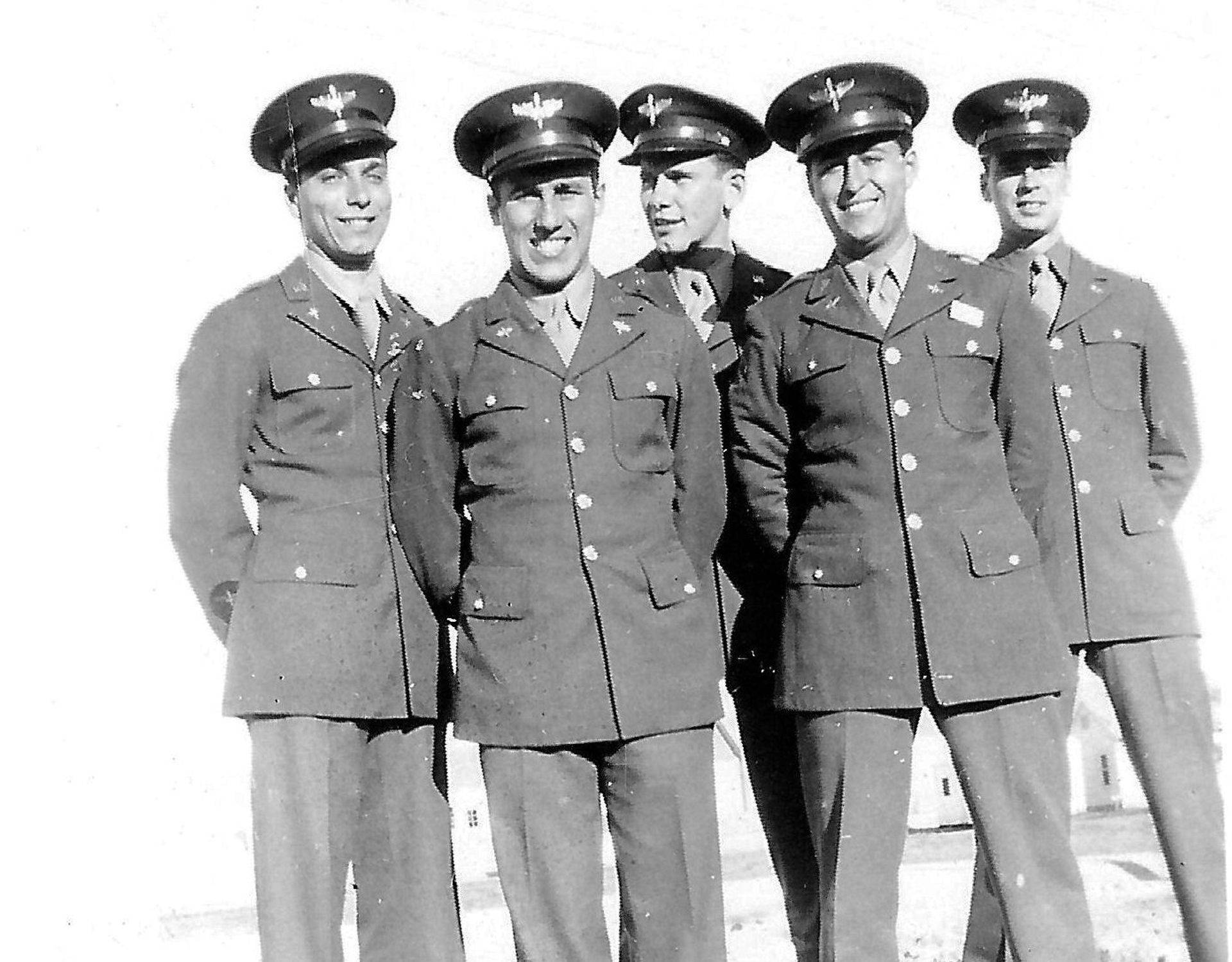
Aviation Cadet Pasquale Collalto (2nd, left) 1943

Vincent Wilde (left), gunnery training at Wendover, Utah in 1943
Photos: Tina Olcheski & Locke Wilde
Crew 70 and B-24H-15-FO 42-52441 J3 I “Last Card Louie“

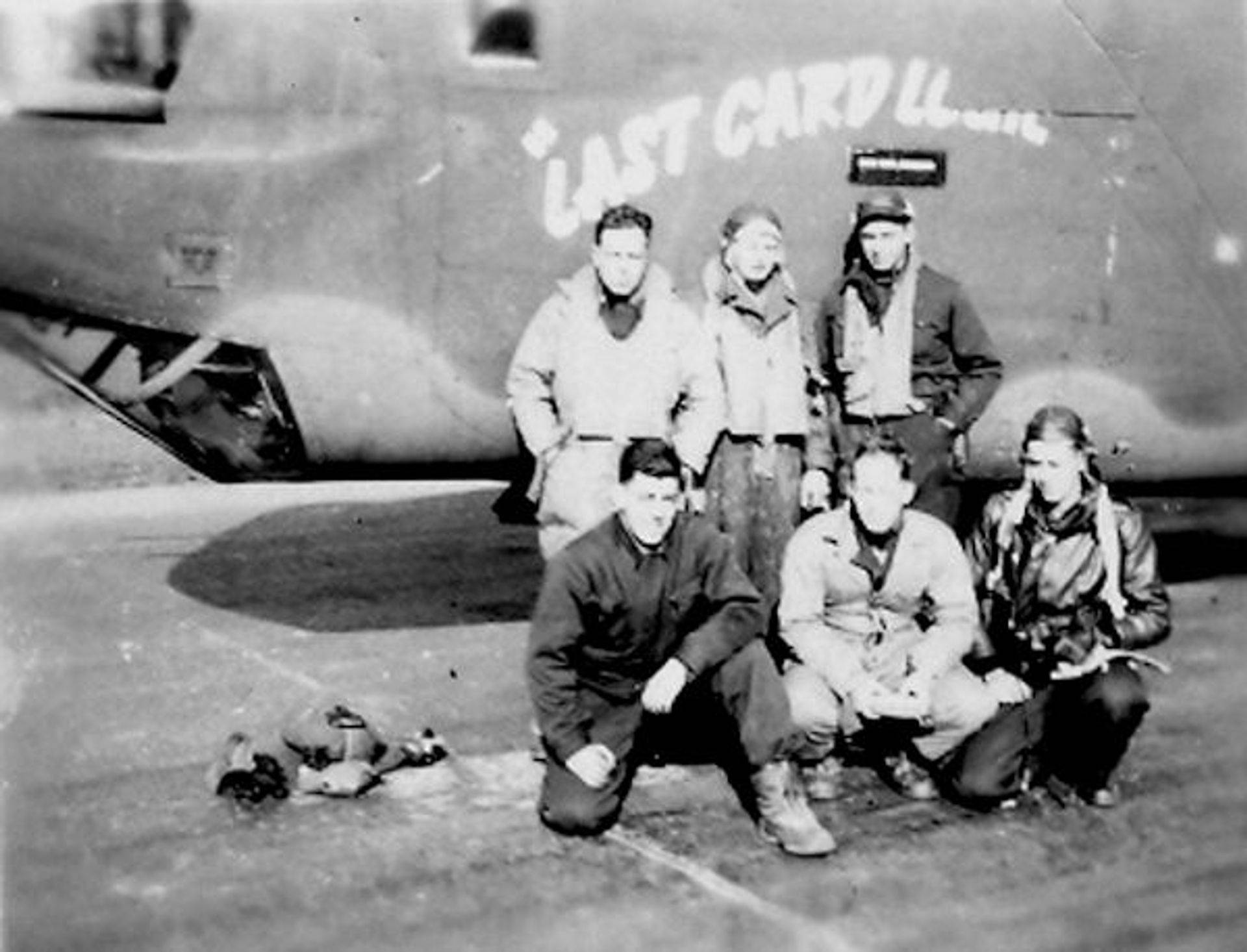
Above: Unidentified members of Crew 70 in front of Last Card Louie.
Left: Pasquale Collalto, Harold Wells, Unknown, and Casey Dills in mid-March 1944
Below: Marshalled and waiting to go…
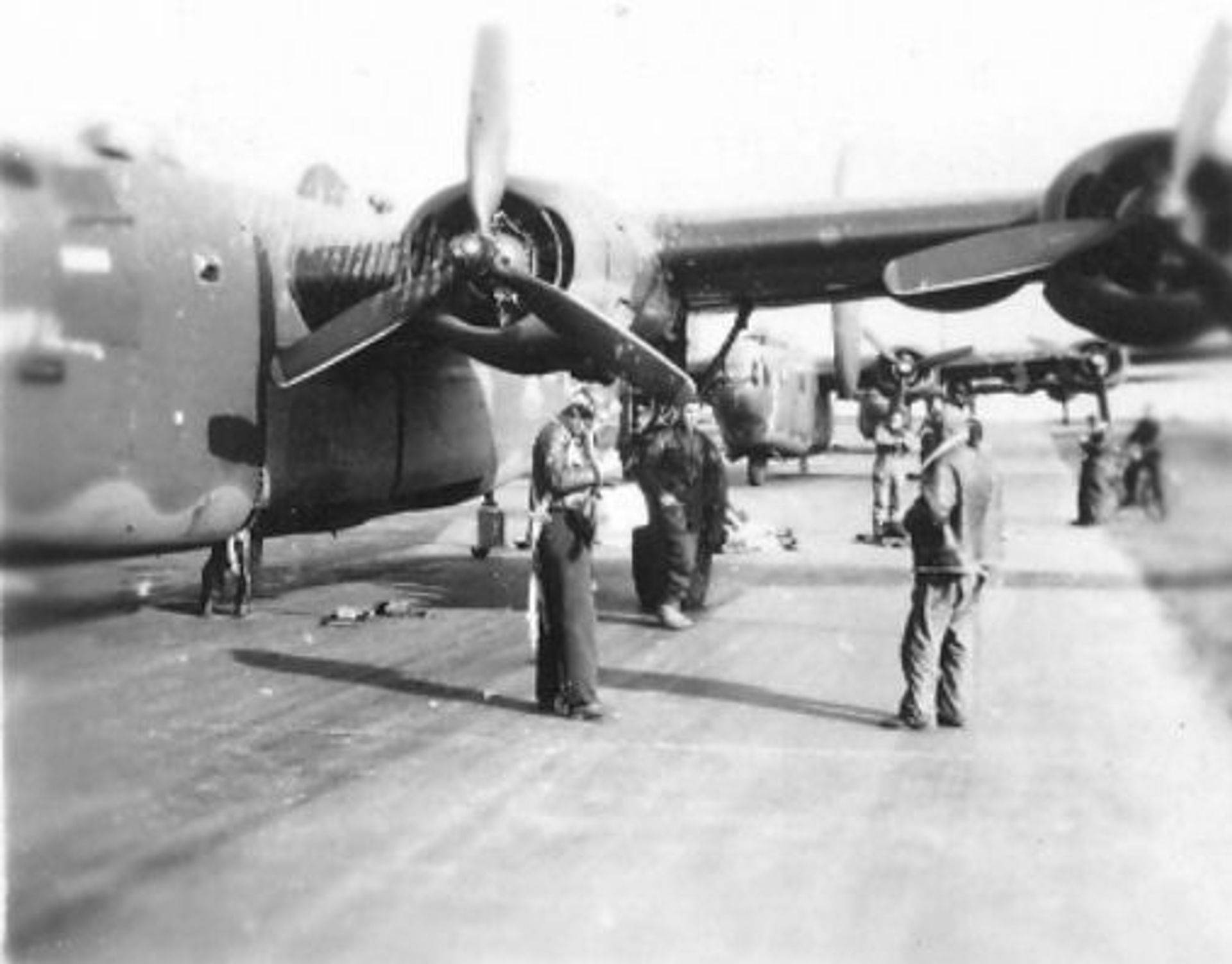
Around Horsham
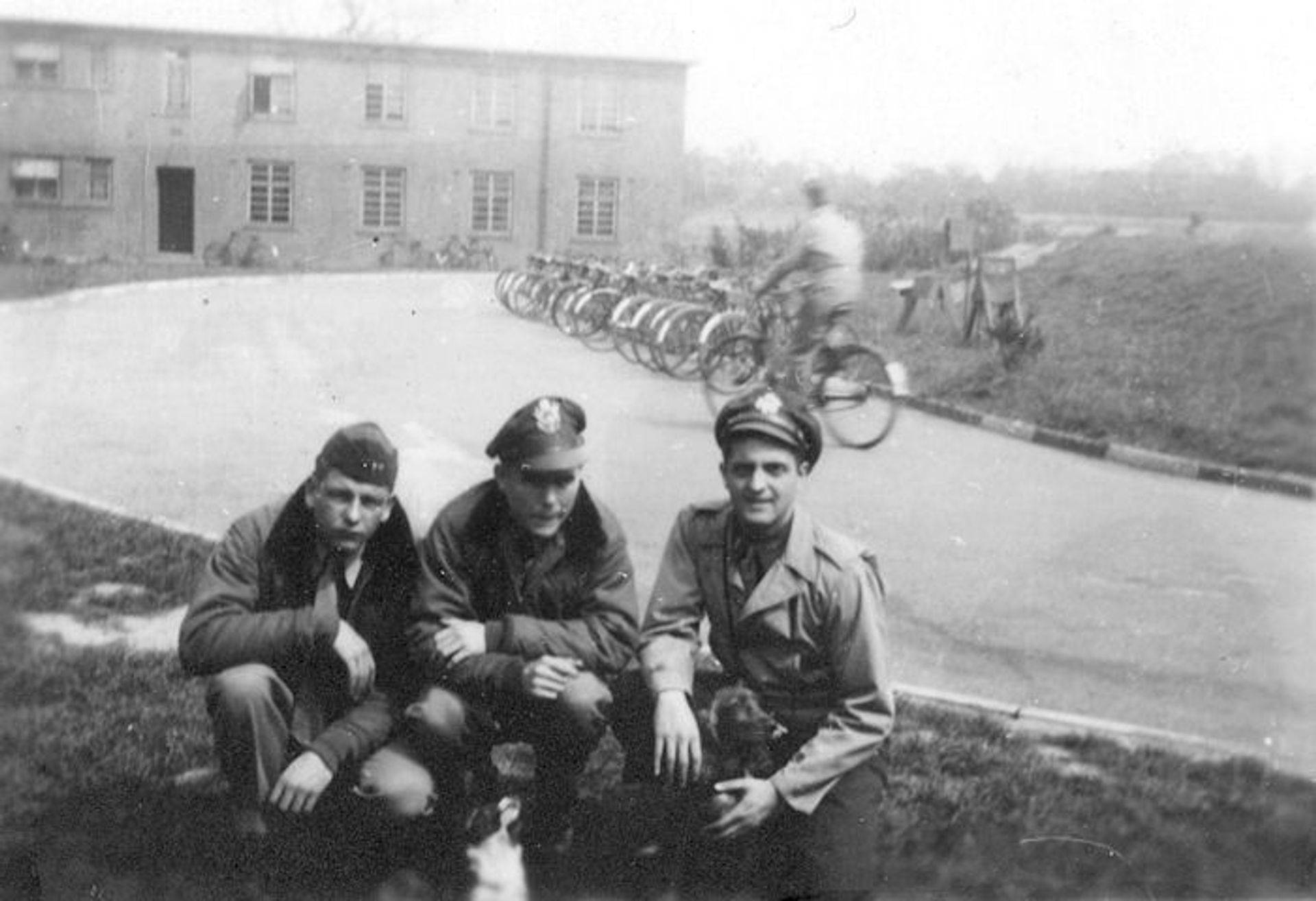
Capt Royce Glenn, Lt Harold Wells, and Lt Robert Nixon with four-legged friends.
Glenn and Nixon were pilot and navigator on Lead Crew 73.
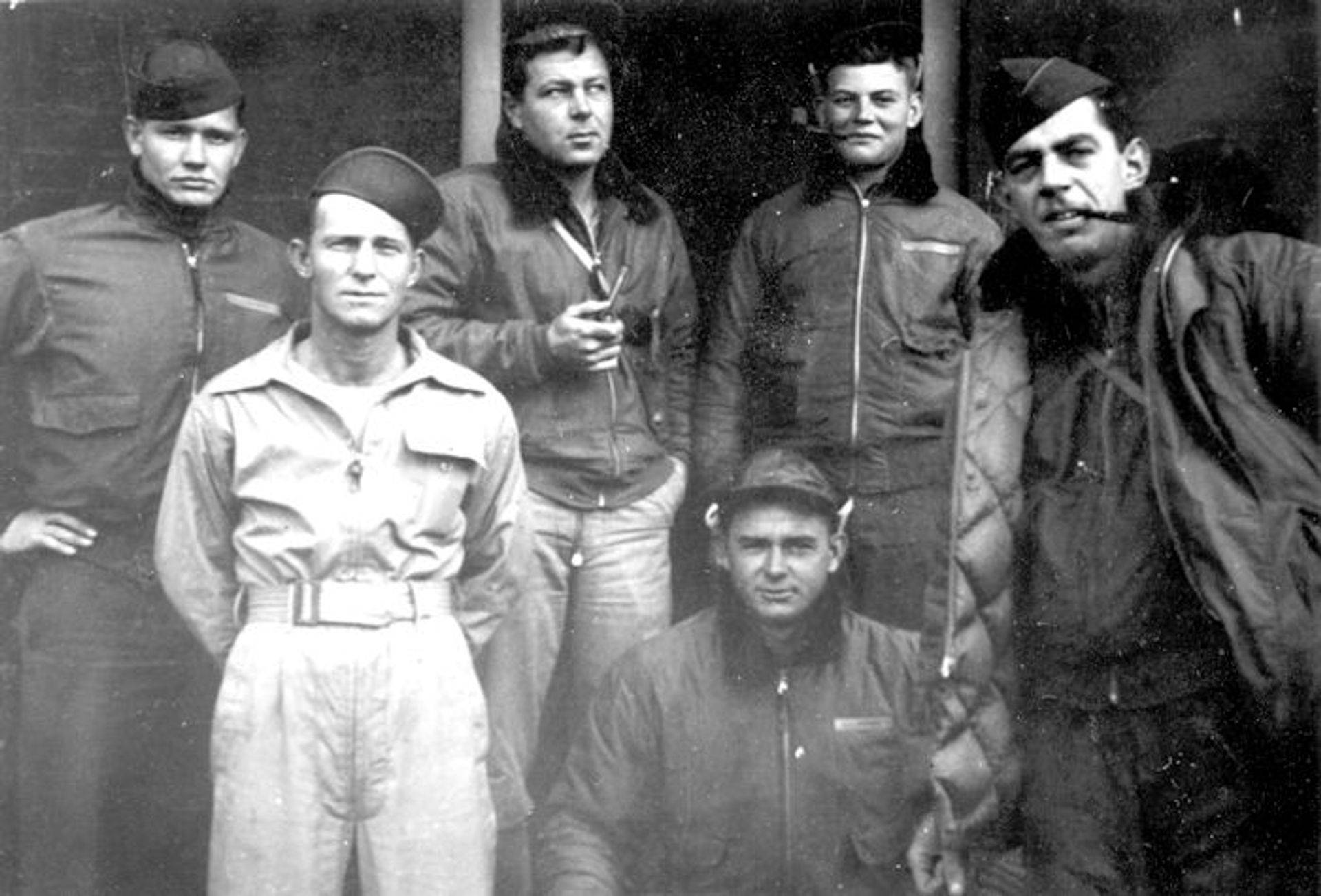
Crew 70 enlisted men outside their barracks
L-R: Larry Forrest, Lewis Brumble, Vincent Wilde, Leonard Perkins (kneeling), George Hoessel, Edward Hayes
Photos: Larry Forrest
April 22, 1944 – Hamm, Germany
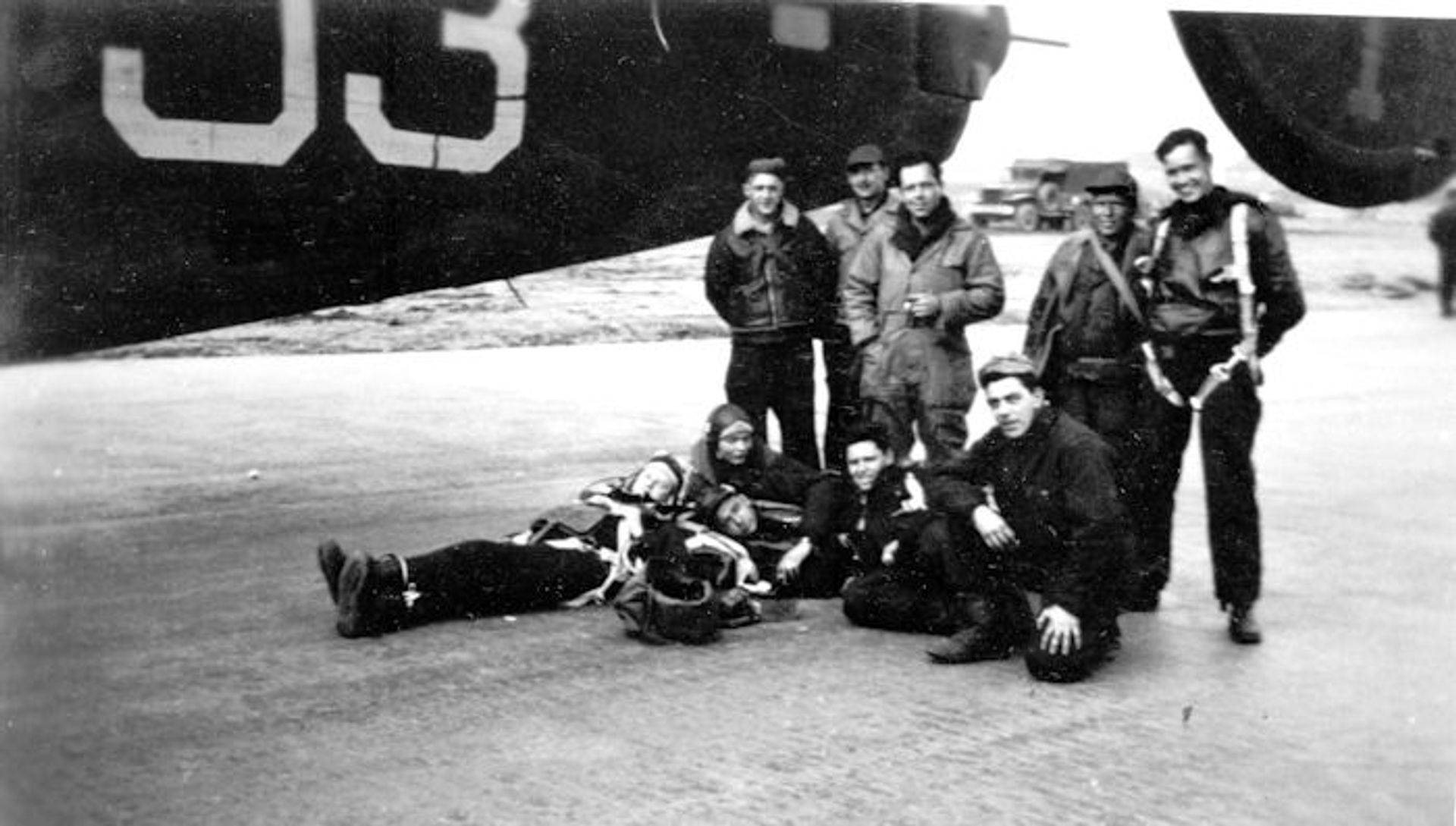
Crew 70 “Sweating out a stand down…” (possibly April 22nd)
Standing: Two ground crew, Vincent Wilde, ground crew, Larry Forrest
Laying down: Casey Dills, George Hoessel, Leonard Perkins (head on parachute), unknown, Edward Hayes
Photo: Larry Forrest
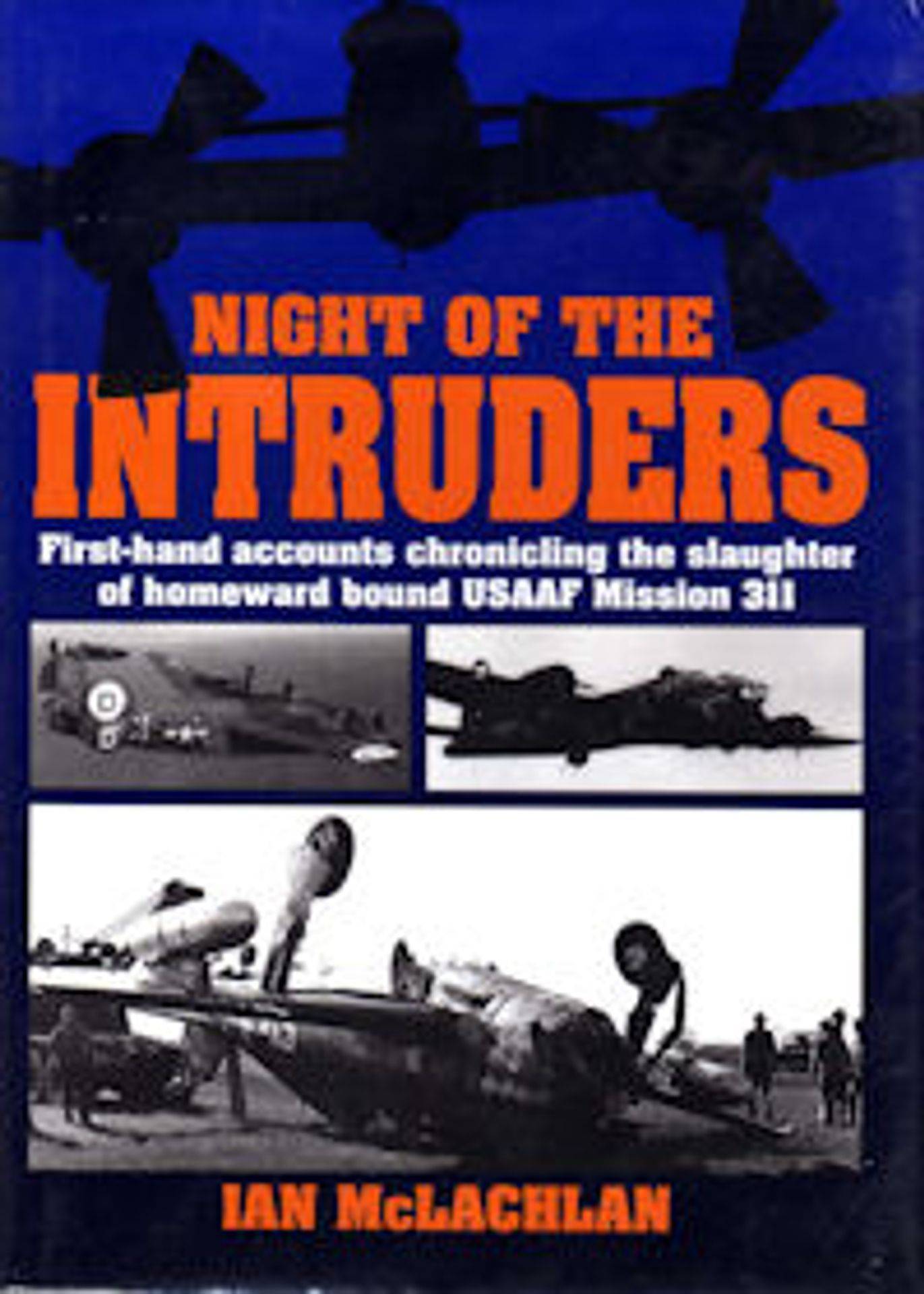
…Sergeant Lewis Brumble, left waist gunner on the aptly named, Last Card Louie, flown by First Lieutenant H. W. Wells, was given credit for the destruction of an Me410 from 6,000 feet at 2230 hours. The Combat Form completed during interrogation reads, “As aircraft was returning to base after missions, enemy intruders attacked around 2215 in darkness. One Me410 made a pass from 2 o’clock high, circled and attacked again. Aircraft was not in any set formation and gunners were all on alert for return of enemy aircraft. When southeast of Rackheath airdrome, Me410 came in again from 2 o’clock low and passed below aircraft 441. Left waist gunner fired at least 100 rounds, tracer hitting behind pilot’s compartment as enemy aircraft passed beyond (our) aircraft. Enemy aircraft fell on right wing and dove straight into the ground on fire. Large explosion when he hit the ground”.
A 389BG Liberator also claimed the destruction of an Me410 in the same area but of two Me410s lost that night, only one was confirmed. Ron Cain of Bergh Apton had been indoors listening to the radio when the drone of many aero-engines drew him outside to observe the spectacle of Liberators landing at night. Watching, he saw a twin-engined aircraft closing in on a B-24 and tracers flashed like an assassin’s dagger. Simultaneously, one of the bomber’s waist guns struck back hitting the intruder which burst into flames. Engines screaming, it dived steeply to oblivion and exploded in a field at Ashby St. Mary.
Visiting the scene very early next morning, Ron saw a large crater surrounded for some distance by scattered unrecognizable debris, but one of the pieces he picked up was marked “Me410”. The nose and engines were buried and young Ron saw a parachute pack amid the wreckage in the hole and, hoping for a prize his chums would envy, he clambered down over lumps of disgorged earth. Reaching his intended trophy, Ron was disappointed to find it so scorched that it disintegrated at the slightest touch, and he scrambled clear in search of other mementos. Meanwhile, his father, Walter Cain, on duty with another Home Guardsman, had the grisly chore of collecting human remains mingled amidst pieces of aircraft. It was a task not for the squeamish. The two men wandered the field using their bayonets like park-keepers, transferring what they found into sacks. During this somber process, Walter Cain found a wallet containing quite an amount of Dutch currency and handed it in to the authorities. Ron was a little less forthcoming with is next find. An unusual feature of the Me410 was its two remotely-operated, rearward-firing 13 mm MG131 machine guns in barbettes on either side of the aft fuselage. Near the edge of the field, Ron found one of these, bent but a superb souvenir, so he surreptitiously dragged it into the undergrowth for later retrieval. Unfortunately, when the time came, it had vanished, apparently found by the RAF recovery team who arrived later that morning. They also recovered the cockpit canopy which had fallen with a flying helmet some distance from the main site, suggesting that the crew had attempted to bale out. At first, only the pilot, Oberleutnant Klaus Kruger could be identified, presumably because of his wallet. His radio operator, Feldwebel Michael Reichardt was not traced until later. Their aircraft, coded 9K+HP, werke number 420458, yielded “no new information” to British Intelligence, nor were the Allies aware that II/KG51 had lost a second aircraft in action over England. Uncertainty surrounds the disappearance of 9K+MN, werke number 420314, because no trace of it has ever been found. Whether it vanished unseen into one of the region’s many broads or, more likely, disappeared limping homewards over the North Sea after sustaining damage is unlikely ever to be known. Its loss was significant because its pilot was the staffel commander, Major Dietrich Puttfarken, along with Oberfeldwebel Willi Lux as his radio operator.
From Night of the Intruders, by Ian McLachlan
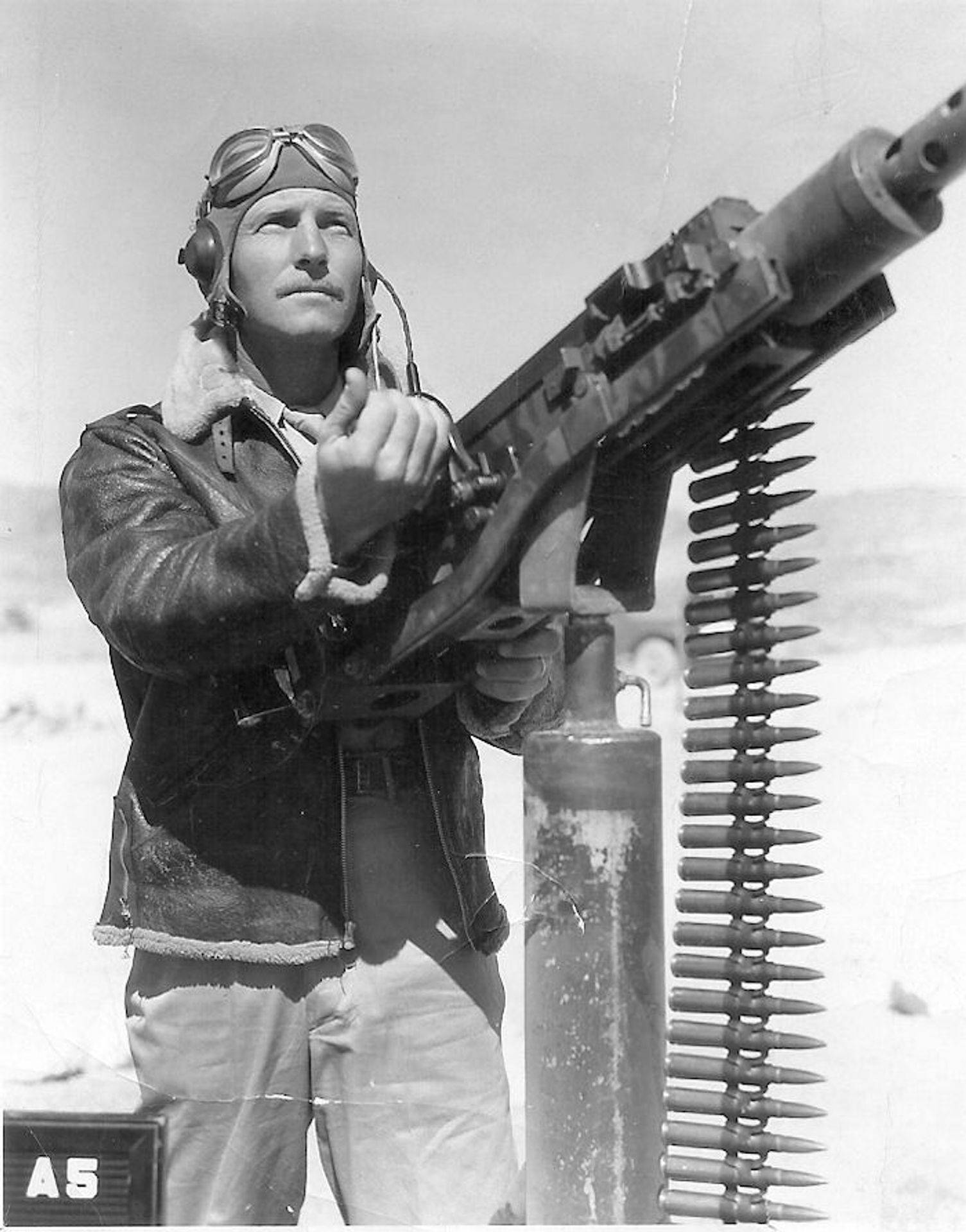
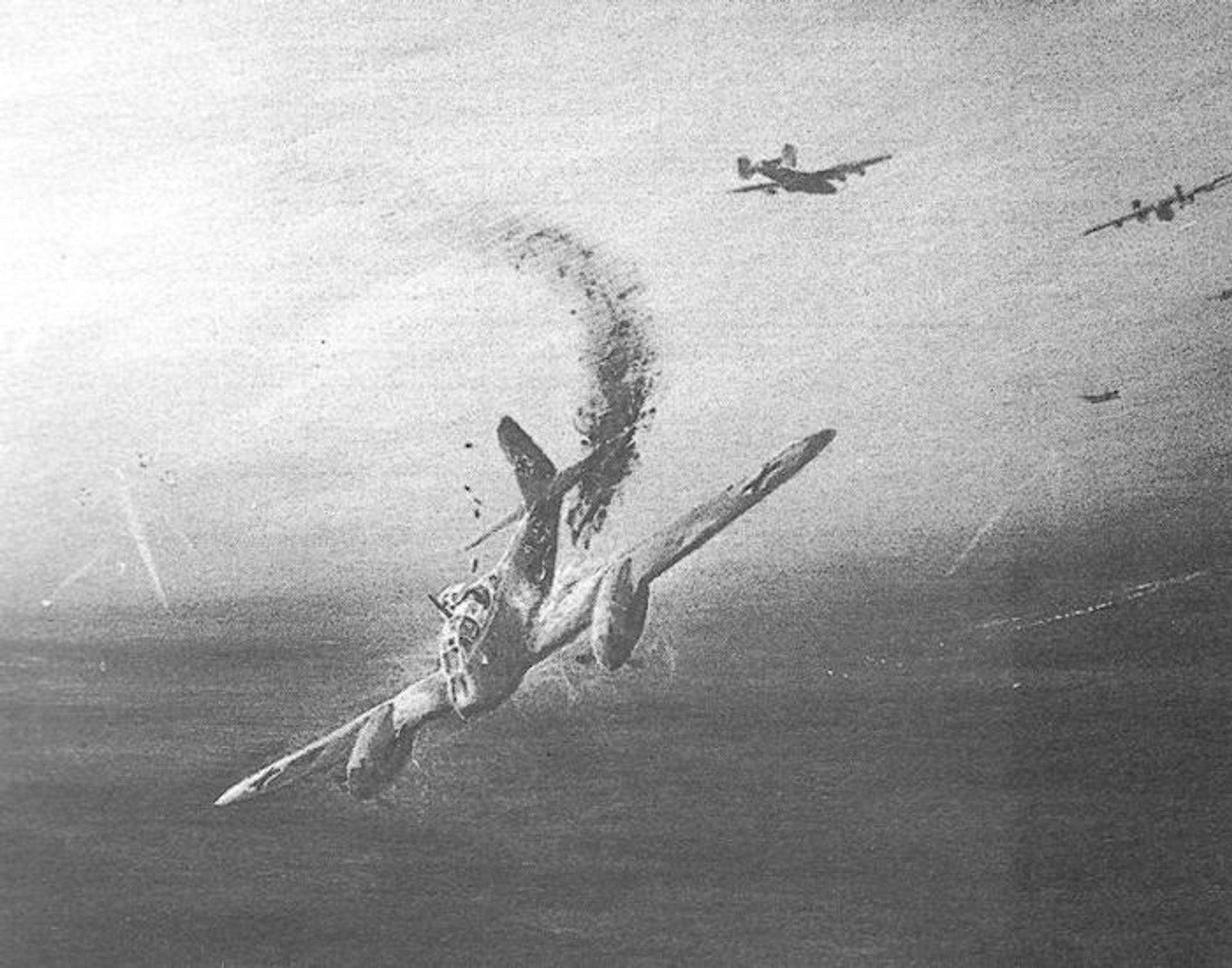
Above: Painting by J. Reeve depicts Me410 going down on April 22, 1944
Left: S/Sgt Lewis Brumble in training, September 1943
(Photos courtesy: Michael Harrison & Greg Spencer)
Flixton Museum Collection

DAIMLER BENZ ENGINE
Engine Werk-Nr. 016xx 38 was manufactured by the German company ‘h s t’ – The Pommersche Motorenbau G.m.g.h. at Stettin Altdamm. It was one of two installed in Messerschmitt 410 A-1 ‘Hornise’ Werk-Nr. 420-458 which went into service with the Luftwaffe unit 6/KG 51 “Edelweiss” coded 9K+HP.
On the night of 22nd April 1944 the aircraft took off from Beuvais in France along with five others for a night intruder raid over Britain. They detected Liberator bombers of the 2nd Air Division returning late to their East Anglia base after a raid on Hamm and six Me410s followed them in over the coast under cover of darkness. The pilot of 9K+HP was Oberleutnant Klaus Kruger and the Observer/Gunner was Feldwebel Michael Reichardt. A Liberator crew of the 389th Bomb Group from Hethel had noticed an aircraft, slightly below, formate on their right wing, but were unable to make out anything other than its navigation lights and took it to be friendly. Moments later the aircraft pulled slightly ahead and let loose a withering hail of fire from its twin 13mm barbette guns, leaving the Liberator crew in no doubt as to its identity. The bomber, fatally hit, crashed at Cantley. Before it did so, however, two gunners were able to overcome their initial surprise and return fire, claiming hits on the Me410 as it broke away from the attack.
At around 2210 hours, Staff Sergeant Lewis Brumble A.M., a left waist gunner with the 458th Bomb Group from Horsham St. Faith, spotted the Me410 coming in from 2 o’clock low position and swung his hand-held .5 machine gun to cover it. As the range closed, Brumble fired over 100 rounds, his tracer shells striking the fuselage below the cockpit before the enemy fighter flashed past below; seconds later the Me410 was seen to be in flames. It veered off on its right wing and went into a steep dive from about 6,000 feet. The crew jettisoned their cockpit hood, but both men were killed when their machine exploded on impact with the ground at Hall Farm, Ashby St Mary, Norfolk.
This rare engine was recovered by members of the Museum’s own Excavation Group at the crash site in September 1979, along with pieces of wreckage and some equipment from the Me410.
Two display cases with some items of Oberleutnant Kruger’s Me410 recovered from the crash site.
Click for larger images
(Courtesy: Michael Harrison)
Deutsche Kreuz im Gold
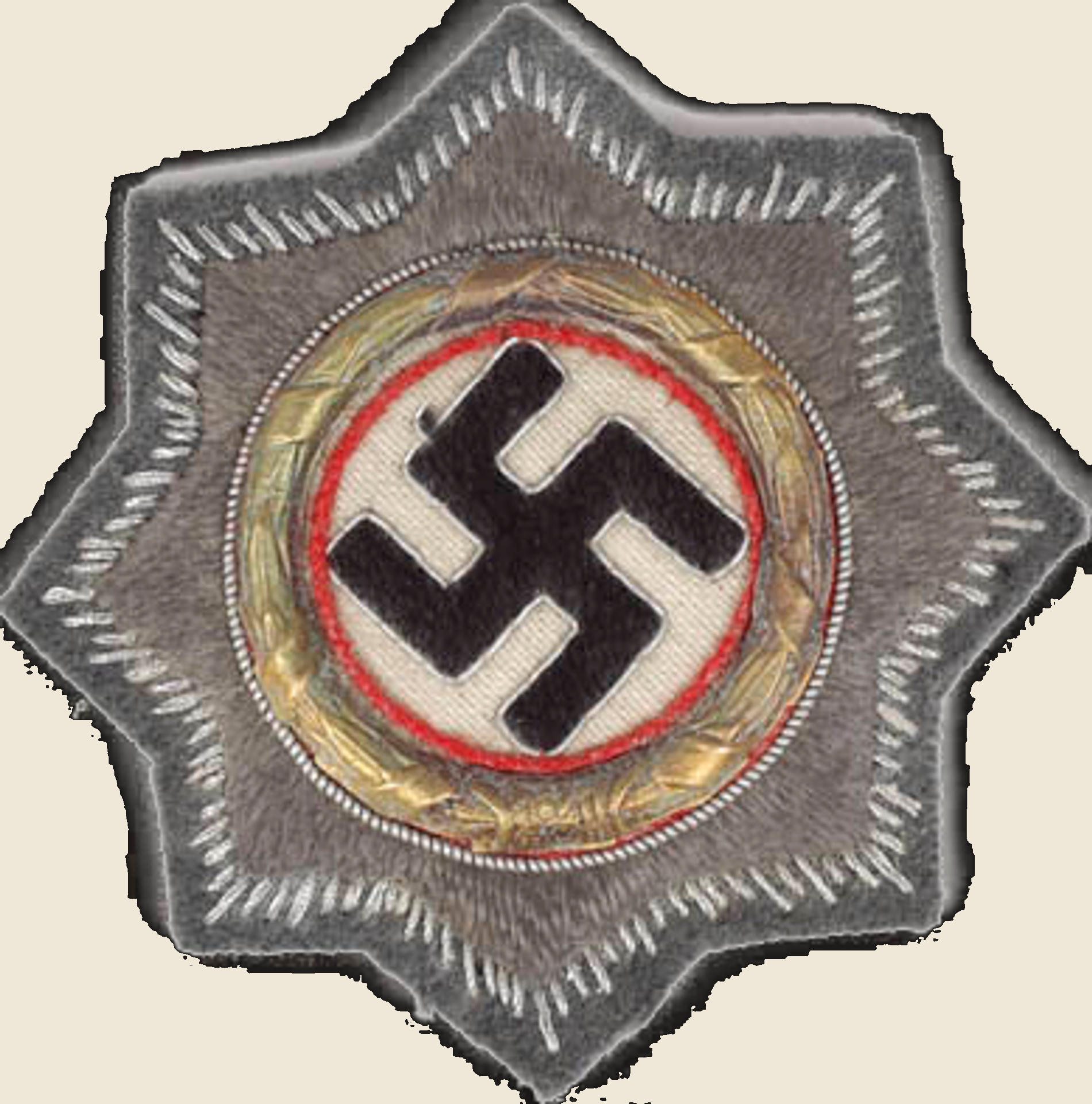
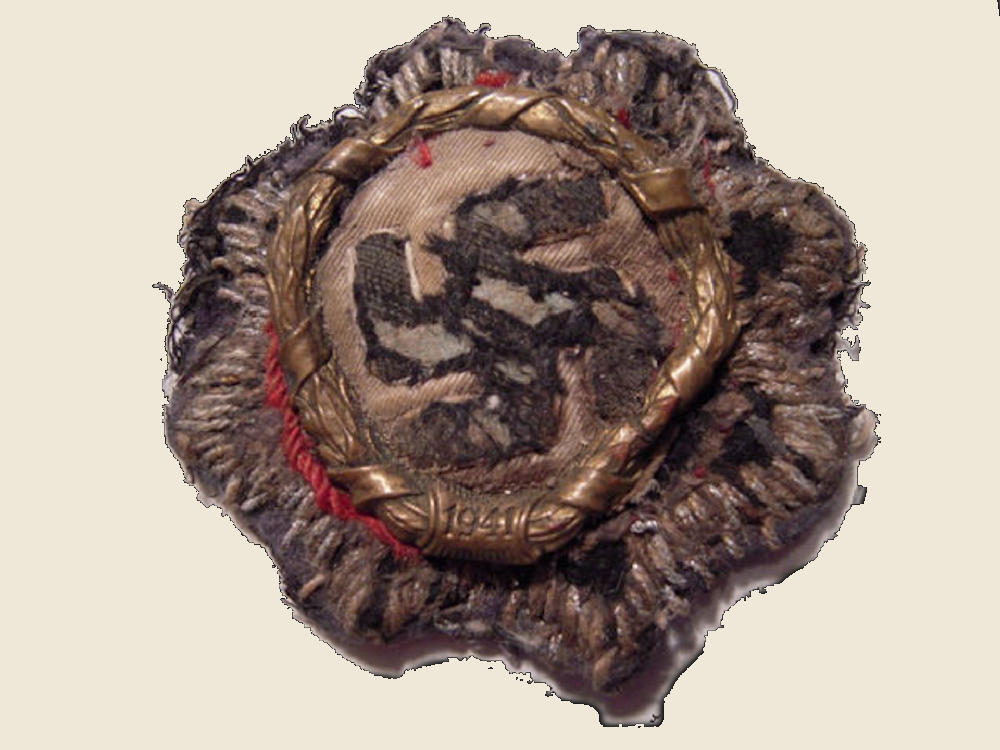
DKiG (left) was awarded to both men on the Me410. The Cloth badge on the right was found near wreckage
From Michael Harrison, whose uncle, Air/Gnr: Sgt. Norris Mervyn Harrison RAF, was killed in action when his Halifax bomber was shot down by intruders upon their return from Karlsruhe on April 24/25, 1944: “The Me410 of KG51, was flown by Oblt.Klaus Kruger and Fw. Michael Reichardt (radio operator) and crashed in a field at Ashby St Mary, 22nd April 1944. I have recently been in contact with a Chris Johnson whose father-in-law was present as a young lad and found the cloth iron cross badge (image above, right) from one of the crew either Kruger or Reichardt? I understand that both men were awarded the DKiG (German Cross in Gold).”
(Photo Courtesy: Harry James Johnson)
June 1944 – Distinguished Flying Cross
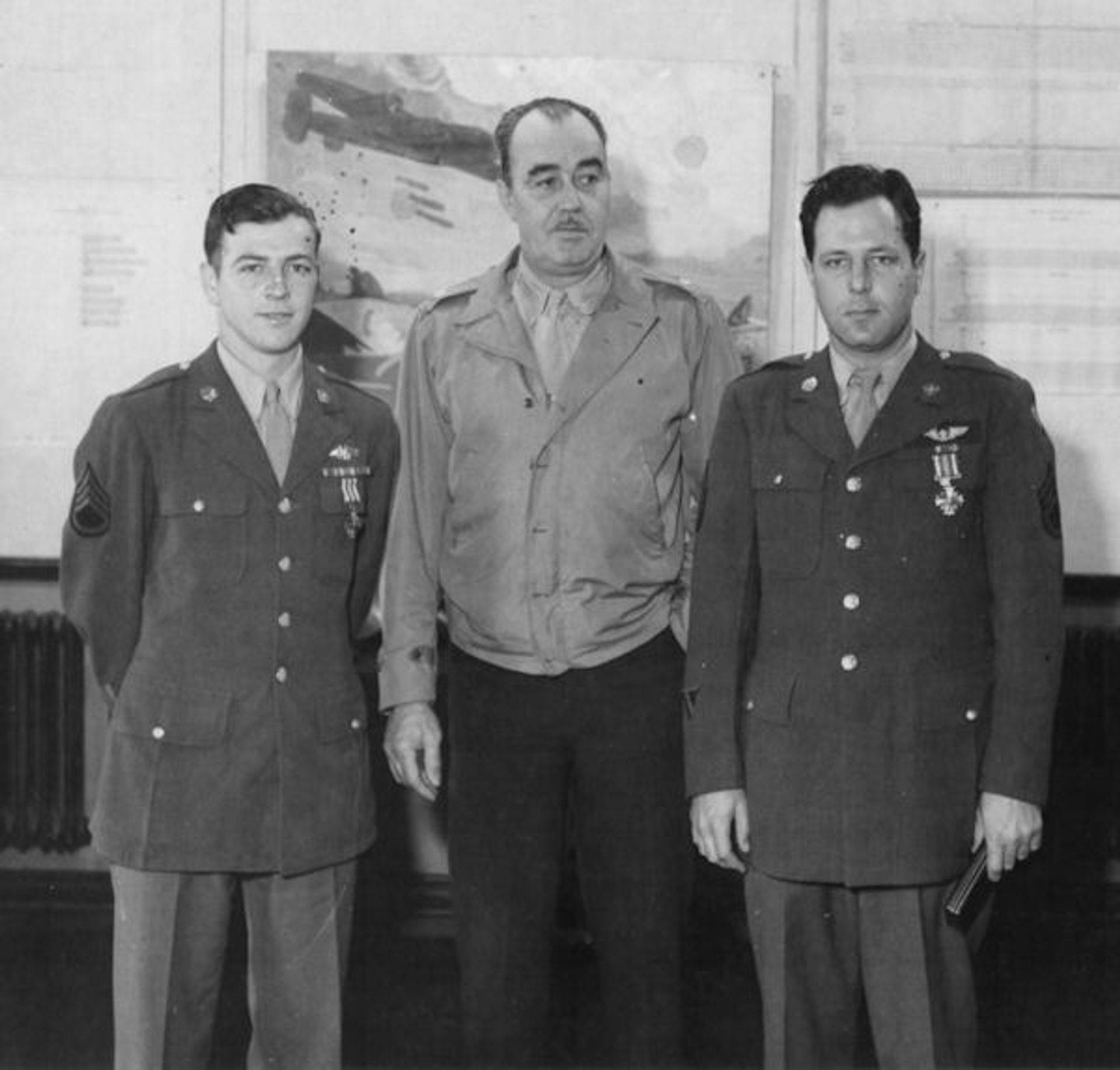
S/Sgt Ray Potts (left)- BTG Crew 74 and S/Sgt Vincent Wilde receive the DFC from 2BD CO Gen Walter Peck
Photo: Locke Wilde

